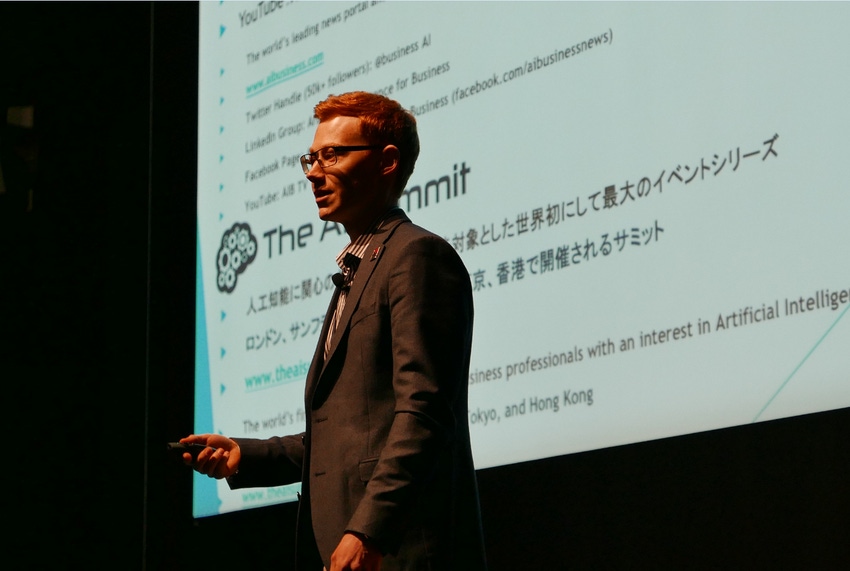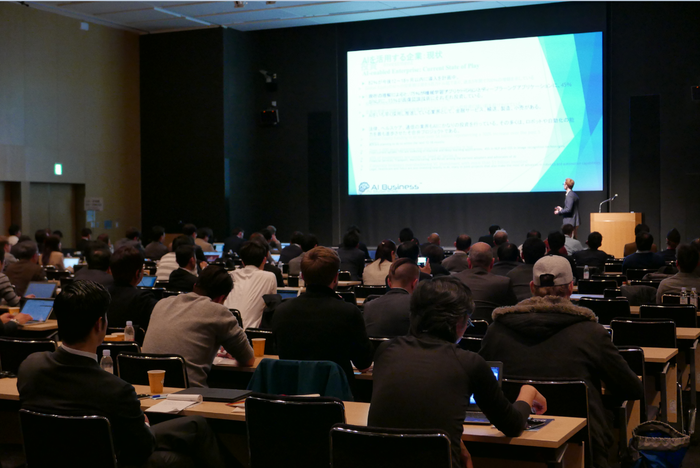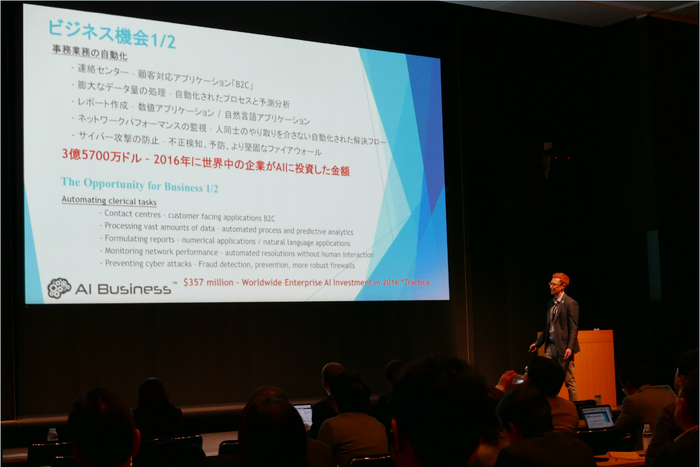CIOs: AI is now top priority for new technology investment
February 10, 2017

Big Data Analytics Tokyo is an event which brings together 400+ experts and entrepreneurs from the US and Japanese tech hubs. The event featured 20+ talks, panel discussions, business pitch sessions, and lightning talks, where all presentations were bilingual with simultaneous interpretation. Whether you are a business leader, data scientist or investor, this event would be of relevance to you.

Presenting at this event was AI Business' Director, Daniel Pitchford, who enlightened the audience about the true business impact of artificial intelligence. Pitchford started off by defining artificial intelligence by looking at practical AI.
Hosting an AI-dedicated event like this in Tokyo was very natural, as Japan is now leading the AI innovation in the Asia-Pacific region. The percentage of Nikkei 225 enterprises already using some form of AI in calculated by AI Business research was at 45% in late 2016, and continuously growing.
In Japan, machine learning and deep learning are the number one in terms of technology investment in AI found among 85% of those who are implementing AI technologies. However, Japanese technology companies are still less outward-facing with their AI products, especially in relation to export markets.
The sectors that are investing the most in AI are manufacturing, technology and financial services, Pitchford explained, saying how Japan is among the leaders across APAC in enterprise AI adoption. Internally in Japan, groundbreaking and world-leading research and product development is taking place and being conducted by major domestic tech-giants, such as NEC, Toshiba, Softbank, Sony and Fujitsu.
“It is narrow AI, not general AI”, Pitchford said, explaining how artificial intelligence is an umbrella term for all of the different types of technology within this space.
Included in AI is machine learning, deep learning, cognitive computing, image recognition and natural language processing, which shows that it is not just a matter of a type of technology, but many different types. “So where are the opportunities for this in businesses?” he asked.

Pitchford explained how the use areas can be divided into two main topics – the first being the automation of clerical tasks, which is highly applicable in contact centres and customer-facing applications, for processing vast amounts of data, formulating reports, monitoring network performance and preventing cyber-attacks.
The second is the enhancing of more complex tasks, bringing AI into collaboration with humans. Predicting human behaviour and enhancing decision-making, enhancing organisational operations by minimising human intervention and increasing accuracy. It is also beneficial in order to improve the customer’s experience and product journey, and it can assist with increasing revenues and speeding up the time to market for new products.
“Advances in Big Data and processing capabilities have made the huge advances in AI over the last couple of years possible”
The US is currently leading the way of AI investment with Europe and Asia following close behind, with implementation rates currently at 20%-35% of their overall potential. Pitchford also revealed that according to AI Business’ research of the FTSE100 and Fortune 500 organisations in 2016, 32% are already implementing AI in some form, and 82% are planning to do so in the next 12-18 months.
Pitchford listed the leaders in the AI space who are developing the technology, and at the forefront are Amazon, Microsoft, Google, Facebook, IBM, HP, Intel, SAP, Salesforce, and many others. However, there has been a significant increase in start-ups too, and across Europe alone more than 400 start-ups focused on AI have been developed.
Looking at investment, today global equity funding in AI has now reached more than $6 billion, which represents a 700% increase over the past five years. With over a thousand deals being done in this time it is evident that the start-up opportunities are very hot and current at the moment.
65% of investments are made at Seed or Series A, and corporate investors are overshadowing VC investment with more than $1 billion invested, Pitchford continued. Leading the way are healthcare companies, with more than $500 million of start-up investment over the past two years.
“So where are the challenges and opportunities?” Pitchford asked. Confusion within organisations over who leads AI projects, from CIOs, CTOs, and all the way through to specialised Labs, there still hasn’t been much talk of a CAIO. “Overall investment and government support for AI still trails that of South Korea and China”, Pitchford said.
However, there are huge opportunities for AI development in Japan, despite the regulatory landscape still being unclear. Public perception is a huge opportunity to advance more adoption by utilising corporate schemes like the American Airlines example in the US.
“Long-term prediction by AI Business shows that South Korea may eventually become the most AI-enabled economy in the region as pace of acceleration and government investment is very high”, Pitchford said.
So what are the CIOs saying about AI globally? AI is now at the top of the agenda when it comes to implementing new technology investment over the 3-5 coming years. Today, the current spending per application ranges from $100K-$200K, but this number is set to increase to over $1million over the next three years.
The current focus for implementing AI is improving efficiencies, reducing costs, and improving creativity within the business, Pitchford said. Customer service is the top area where the biggest opportunities of AI is seen, followed close by marketing, sales and process management.
“Unemployment and data privacy are among the most pertinent issues CIOs see affecting their organisation through implementing AI”, Pitchford said, explaining how the ultimate decision making on AI still sits between multiple roles including the CIO, CTO, Head of Analytics/Data, and Business Unit Leads.
Where does the AI sit within the business then? Traditionally it sits with the remit of the CIO, but more widespread applications mean that AI is now relevant to the entire board, but most of all, the CEO.
“No two businesses are yet following the same thought-process for where to hand responsibility, which can cause paralysis in some cases”, Pitchford said. However, he did mention that new roles appearing included CDO, and CAO, which subsequently means that there is even further confusion as to where AI belongs.
“The argument for when we start to see the CAIO has already begun.”
You May Also Like
.jpg?width=700&auto=webp&quality=80&disable=upscale)
.jpg?width=700&auto=webp&quality=80&disable=upscale)
.jpg?width=700&auto=webp&quality=80&disable=upscale)
.jpg?width=300&auto=webp&quality=80&disable=upscale)
.jpg?width=300&auto=webp&quality=80&disable=upscale)
.jpg?width=300&auto=webp&quality=80&disable=upscale)

